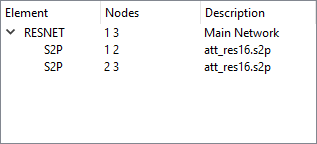A particularly useful feature provided by a netlist project is the ability to cascade multiple S-, Y- and Z-parameter data files. There are no restrictions on the file formats which may be cascaded. For example, you can cascade em Z-parameter data in Touchstone format with measured S-parameter data in MDIF format. In addition, em can analyze at frequencies which are not included in the data files. Em automatically interpolates if there are any differences between the requested frequency points and those in the data files.
A good example of a cascading operation is the project att_cascade.son, which is included in the Att example. A schematic representation of the two-port circuit is shown below. This circuit consists of two identical thin film resistors connected in series. The S-parameters from the geometry project analysis on the thin-film resistor are used as a data file element in the netlist. The desired output network is the series combination of resistors. The S-Parameter data file, att_res16.s2p, as well as the geometry project, att_res16.son, used to generate the data file, are included in the Att example.

The netlist, att_cascade.son, for the circuit is pictured below.

The main network, Resnet, has two ports.. Port 1 corresponds to node 1 in the network. Port 2 corresponds to node 3. There are two data file elements in the network. The first entry is the response file att_res16.s2p with 2 ports. Port 1 corresponds to node 1 of the network, which, as mentioned above, is port 1 of the whole circuit. Port 2 for the data file corresponds to node 2 of the network. The other entry is also for the data file att_res16.s2p except that port 1 of the data file goes to node 2 of the network which means that port 1 of the second data file is connected to port 2 of the first data file. Port 2 of the second data file corresponds to node 3 of the network. Node 3 of the network is Port 2 of the network “RESNET”.
The S-Parameters for an analysis of the netlist are shown below.
